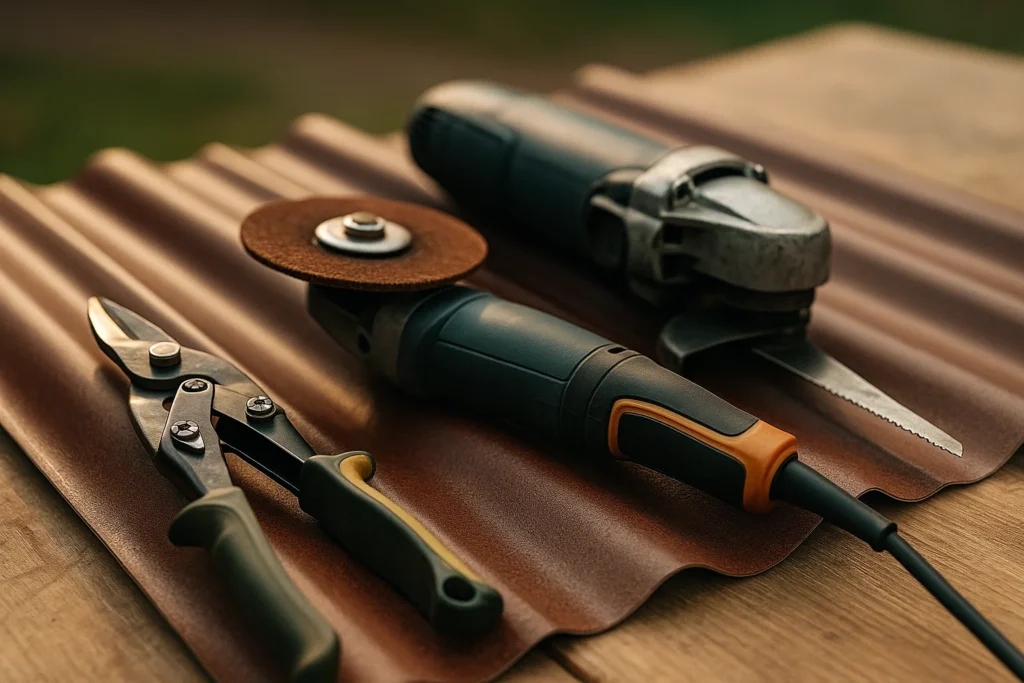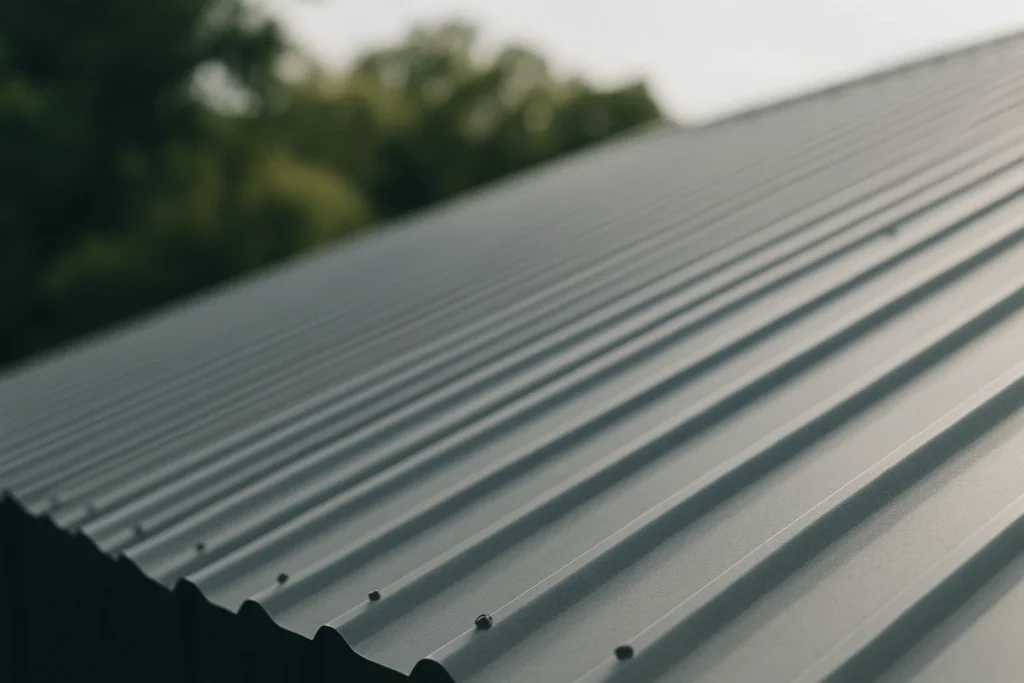Metal Metal roofing is known for its strength, durability, and high energy efficiency, 40-70 year life, and protection in ever changing weather. Correct cutting is highly important to provide an accurate fit and to keep the face of the material intact during installation. Knowing how to cut metal roofing can be the difference in making a successful home improvement or repairing project. In this guide, you will learn all of the vital tools required, techniques to use, and safety precautions to follow to ensure you cut metal roofing the right way and don’t end up making any mistakes.
Why Cutting Metal Roofing Requires Care
Material Integrity and Performance
Cutting through metal roofing requires a finesse that is not there with cutting through other types of materials. Metal roofing products are designed to be installed with certain dimensions and edge details to insure that they develop weatherproof seals. Poor cutting techniques can:
- Corrosion preventing damage protective coatings
- Add in rough edges that allow water to pour in
- Undermine the structural integrity of systems that lock together
- Result in spaces that compromise energy efficiency
- Leave vulnerable, sharp edges that are dangerous to the installer
Safety Considerations
Metal roofing materials present unique safety challenges that require careful attention:
Sharp Metal Edges and Filings: The process of cutting metal leads to the formation of dangerously sharp edges and metallic filaments. You should always wear a good pair of work gloves, safety goggles, and call today to have long-sleeve pants before cutting metal roofing materials.
Tool Safety: Power cutting tools used in cutting (metal) can give unpredictable kicks back or become out of control. 5) Never let workpieces be loose and the site of cutting tools locked.
Fire danger: Certain cutting techniques can produce sparks that will burn combustibles in the vicinity. If working indoors, work in a well ventilated area and stay away from flammable materials and have fire extinguishers near when operating tools with power.
Best Tools for Cutting Metal Roofing

Selecting the best tool to cut metal roofing depends on the material thickness, cut complexity, and project scope. Here’s a comprehensive breakdown of available options:
Metal Shears
Handheld Metal Shears The heavy duty metal shears are best suited for cutting thin to medium-gauge metal roofing materials. They make straight cuts as well as gentle curves with ease, and they don’t get hot or spark.
What they’re best for: Aluminum and thin steel sheets (up to 18-gauge) Pros: Performs with precision, no heat — or blowback, for that matter-, virtually silent operation Cons: Limited to thin materials, and you’ll need substantial hand strength
Electric Metal Shears: Electric powered shears integrate hand operated structural shears with electric power to make your job easier when you’re cutting material.
Pros: Grants much easier effort, even cutting speed, reasonable accuracy Cons: More pricy than manual, will require power
Power Saws
Circular Saws with Metal Cutting Blades Circular saws equipped with metal cutting blades can handle thick materials and long straight cuts efficiently. Use carbide-tipped blades designed specifically for metal cutting.
Best For: Thick steel roofing, long straight cuts, production work Advantages: Fast cutting, handles thick materials, versatile Precautions: Generate heat and sparks, require steady hands, can overheat material
Reciprocating Saws Reciprocating saws with metal cutting blades offer versatility for various cut types, including curves and cutouts for vents or skylights.
Best For: Curved cuts, demolition work, vent openings Advantages: Versatile cut angles, good for tight spaces, relatively inexpensive Limitations: Can produce rough edges, blade wear is high
Tin Snips
Tin snips Traditional tin snips are the standard metal roofing tool for making cuts in tin roofing and for making cuts and details in lighter materials.
Straight Snips Ideal for straight 1 Straight and slight curve cuts in thin materials.
Left and Right-Cut Snips Snips specially designed for cutting bends to the left or right without damaging the material.
Pros: Affordable, precise control, no electricity needed Cons: Only cuts thin materials, labor-intensive for large jobs Suitable Products: Thin tin roofing, small repairs and detail work
Specialized Roof Cutters
Standing Seam Roof Cutters Purpose-built tools designed specifically for cutting standing seam metal roofing without damaging the profile or coatings.
Best For: Standing seam systems, professional installations Advantages: Designed for specific applications, minimal material damage Limitations: Specialized use only, higher cost
Drill Attachments for Metal Cutting
Nibbler Attachments Drill-powered nibblers cut metal by punching small overlapping holes, creating smooth cuts without heat generation.
Best For: Curved cuts, detailed work, thick materials Advantages: No heat generation, smooth cuts, handles thick materials Limitations: Slower cutting speed, creates small waste pieces
How to Cut Different Types of Metal Roofing
Steel Roofing
How to cut steel roofing depends largely on thickness and coating type. Steel roofing typically ranges from 26-gauge (thinnest) to 22-gauge (thickest) in residential applications.
For Thin Steel Roofing (26-24 gauge):
- Mark your cutting line clearly using a straight edge and permanent marker
- Secure the steel sheet with clamps to prevent movement
- Use metal shears for metal roofing or heavy-duty tin snips for straight cuts
- Cut slowly and steadily to avoid distorting the material
- File or sand rough edges smooth after cutting
For Thick Steel Roofing (22-gauge and heavier):
- Mark cutting lines and secure the material firmly
- Use a circular saw with a metal cutting blade or electric shears
- Cut at moderate speed to prevent overheating the material
- Allow the material to cool between cuts if it becomes hot
- Clean metal shavings from the work area regularly
Safety Tips for Steel Cutting:
- Always wear safety glasses and heavy gloves
- Support both sides of the cut to prevent binding
- Keep cutting blades sharp to reduce required force
- Work in well-ventilated areas when using power tools
Tin Roofing
Cutting tin roofing typically involves thinner materials that are easier to handle but require careful technique to avoid distortion.
Step-by-Step Guide for Tin Roofing:
- Measure and Mark
- Use a measuring tape and straight edge to mark cutting lines
- Double-check measurements before cutting
- Mark on the back side of the material when possible
- Secure the Material
- Clamp tin roofing to a stable work surface
- Ensure adequate support on both sides of the cut line
- Use protective padding to prevent clamp marks
- Choose Your Tool
- Use tin snips for cuts shorter than 2 feet
- Switch to metal shears for longer straight cuts
- Consider electric shears for multiple cuts
- Make the Cut
- Start cutting from one end, maintaining steady pressure
- Keep the tool perpendicular to the material
- Avoid forcing the cut, which can cause distortion
- Finish the Edge
- File or sand sharp edges smooth
- Check the fit before final installation
- Apply touch-up coating if the cut edge exposes base metal
Corrugated Metal Roofing
How to cut corrugated steel requires special attention to the material’s ribbed profile, which can complicate cutting and measuring.
Specific Techniques for Corrugated Metal:
Measuring and Marking
- Always measure from the same reference point (typically a rib peak)
- Use a flexible measuring tape that follows the corrugated profile
- Mark cutting lines on both peaks and valleys for accuracy
Cutting Across Ribs (Perpendicular Cuts)
- Use metal shears or circular saw with metal cutting blade
- Cut through one rib at a time for better control
- Support the material adequately to prevent flexing
- Maintain steady cutting speed to avoid rough edges
Cutting Along Ribs (Parallel Cuts)
- Use tin snips or metal shears for thin materials
- Follow the valley between ribs for easiest cutting
- Consider using a reciprocating saw for thick corrugated steel
- Clean out metal shavings from the corrugated grooves
Special Considerations:
- Corrugated metal can trap cutting debris in the grooves
- Extra support is needed due to the material’s flexibility
- Plan cuts to maintain structural integrity of the corrugated pattern

Tips for Making Clean Cuts
Achieving professional results when cutting metal roofing requires attention to detail and proper technique:
Use Proper Guides and Supports
Straight Edge Guides
- Use a quality metal straight edge or level as a cutting guide
- Clamp guides securely to prevent movement during cutting
- Check guide alignment before starting each cut
Adequate Support
- Support the material on both sides of the cut line
- Use sawhorses or a stable work table
- Prevent the material from sagging or flexing during cutting
Maintain Sharp Tools
Blade Maintenance
- Keep cutting blades sharp to reduce required force
- Replace blades at first signs of dullness
- Clean blades regularly to prevent material buildup
Tool Calibration
- Ensure power tool guards are properly adjusted
- Check that shear blades are properly aligned
- Lubricate moving parts according to manufacturer recommendations
Cutting Technique Best Practices
Steady, Consistent Movement
- Maintain steady cutting speed for smooth edges
- Avoid stopping and starting in the middle of cuts
- Keep tools perpendicular to the material surface
Proper Material Handling
- Secure workpieces with adequate clamping
- Use helper supports for large sheets
- Wear appropriate safety equipment throughout the process
Common Mistakes to Avoid
Learning from common errors can save time, materials, and prevent safety issues:
Tool Selection Errors
Wrong Tools for Material Thickness: Many DIYers try to cut thick steel with tin snips or thin aluminum with saws meant for heavy material. Use,Select the best cutting tools for the job.
Dull Or Wrong Blades: Leave Use of wood cutting blades on metal or using incorrect blade for task produce poor quality cuts and pose safety hazards. Use only sharp, metal cutting tools.
Safety Equipment Oversights
Inadequate Personal Protection Metal cutting creates sharp edges and flying debris. Always wear safety glasses, heavy gloves, and appropriate clothing. Don’t shortcut safety for convenience.
Fire Safety Negligence Power tools generate sparks that can ignite nearby materials. Clear work areas of flammable materials and keep fire safety equipment accessible.
Technique Problems
Overheating Material Cutting metal roofing too quickly with a power tool can cause the materials to overheat, thus damaging protective coatings and altering its shape. Use moderate cutting speeds and provide time for cooling.
Insufficient Measurement or Planning Twice prove the maxim that you should measure twice and cut once applies doubly to metal roofing. Check all your measurements twice and think through any cuts to minimize wasted materials and misfits.
Insufficient Material Support Unsupported materials may grab cutting tools or produce poor cuts. Make sure you support properly on both sides of the cut line at all times.
Installation Integration Issues
Ignoring Expansion Requirements Metal roofing expands and contracts with temperature changes. Plan cuts to accommodate thermal movement in the installed roof system.
Compromising Weatherproofing Rough cuts or damaged edges can compromise the roof’s weather resistance. Take time to finish cut edges properly and maintain sealing integrity.
Conclusion
Successfully cutting metal roofing requires the right combination of tools, techniques, and safety practices. Whether you’re working with steel, tin, or corrugated materials, proper preparation and tool selection are essential for achieving professional results.
Remember that the best tool to cut metal roofing varies based on your specific application, material thickness, and cutting requirements. Take time to select appropriate tools, maintain them properly, and always prioritize safety throughout your project.
Frequently Asked Questions
Most applications require the use of metal shears, which offer the cleanest cuts, and circular saws with metal blade which are appropriate in thick materials and lengthy cuts. Select the tools depending on the thickness of the material as well as the complexity of the cut.
No, regular wood-cutting blades will dull quickly and produce poor results. Always use blades specifically designed for metal cutting to ensure clean cuts and tool longevity.
Cut at moderate speeds, allow cooling time between cuts, and use cutting fluids when appropriate. Overheating can damage protective coatings and distort the material.
Essential safety equipment includes safety glasses, heavy-duty work gloves, long sleeves, and hearing protection for power tools. Consider respiratory protection when cutting creates significant dust.
While possible, cutting installed roofing is challenging and risky. It’s much safer and easier to cut materials before installation whenever possible.
Use a quality straight edge as a guide, clamp materials securely, and maintain steady tool movement. Pre-marking cut lines and using proper supports ensures accuracy.







